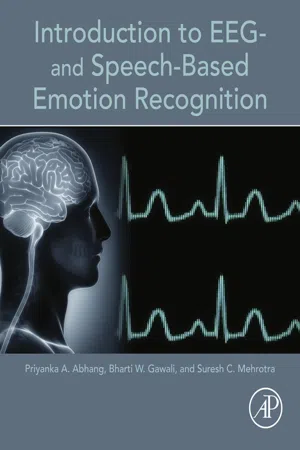1.1. Introduction
In a very real sense, we have two minds, one that thinks and one that feels.
Daniel Goleman, Emotional Intelligence.
Emotions are intrinsically connected to the way that people interact with each other. Emotion constitutes a major influence for determining human behaviors. A human being can read the emotional state of another human, and behave in the best way to improve their communication at that moment. This is because emotions can be recognized through words, voice intonation, facial expression, and body language.
Emotions have been studied in scientific disciplines such as physiology, psychology, speech science, neuroscience, psychiatry, communication, and so on. As a result, distinctive perspectives on the concept of emotions have emerged, appropriate to the complexity and variety of emotions. It is important to see these different perspectives as complementary to each other.
In humans, emotions fundamentally involve physiological arousal, expressive behaviors, and conscious experience. Thus in that respect there are three views of emotions.
• Psychological (what one is thinking).
• Physiological (what one's body is doing).
• Expressive (how one reacts) in nature.
It is thought that emotions are predictable, and are settled in the different regions in the brain depending on what emotion is invoked. An emotional reaction can be separated into three major categories: behavioral, automatic, and hormonal.1
In psychology, expression of emotion is viewed as a reaction to stimuli that involves characteristic physiological changes. According to psychology, an emotion is seen as a disturbance in the homeostatic baseline. Based on these changes, the properties of emotions can be represented as a three-dimensional construct. Essential dimensions of emotional states are measured by the features of activation.
• Arousal: measured as an intensity.
• Affect: valence of pressure, measured as positive or negative feeling after emotion perception.
• Power (control): measured as dominance or submissiveness in emotion expression.
Thus the psychology of emotions can be viewed as a complex experience of consciousness (psychology), bodily sensation (physiology), and behavior (active speech). Orientational dimensions of emotional states are captured by the features of activation, affection, and power.
The emotions generally represent a synthesis of subjective experience, expressive behavior, and neurochemical activity. In the physiology of emotion production mechanisms, it has been found that the nervous system is stimulated by the expression of high-arousal emotions such as anger, happiness, and fear. This phenomenon causes an increased heart rate, higher blood pressure, changes in respiratory pattern, greater subglottal air pressure in the lungs, and dryness in the mouth.2
Emotions are generally expressed in positive and negative ways. The positive emotions such as happiness, excitement, joy, etc. are pleasant and are seen as constructive in an individual, whereas negative emotions such as sadness, anger, fear, etc. are considered unpleasant and may be considered to be destructive for an individual.
According to Robert Plutchik,3 any emotion is based upon one of six primary emotions. Happiness, sadness, anger, disgust, fear, and surprise are considered as the main or basic emotions by most researchers and are known as archetypal emotions.4
1. Happiness is the emotion that expresses various degrees of positive feelings, ranging from satisfaction to extreme joy.
2. Sadness is the emotion that expresses a state of loss or difficulty. Sadness causes individuals to be slow at processing information.
3. Anger is the emotion that expresses dislike or opposition toward a person or thing that is causing aversion. Anger is sometimes displayed through sudden and overt aggressive acts.
4. Disgust is the emotion that expresses a reaction to things that are considered dirty, revolting, contagious, contaminated, or inedible. Disgust is associated with a distinct facial expression and a drop in heart rate.
5. Fear is the emotional reaction to an actual and specific source of danger. Fear is often confused with anxiety, which is an emotion that is often exaggerated and experienced even when the source of danger is not present or tangible.
6. Surprise is the emotion that arises when an individual comes across an unanticipated situation. A surprise emotion can be a positive, neutral, or negative experience. A human being can understand the emotional state of another human being and behave in the best manner to improve the communication in a certain situation. This is because emotions can be recognized through various modalities such as words, voice intonation, facial expression, body language and by brain signals.5
